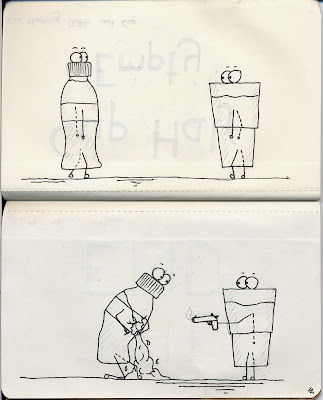Choose two artists whose work addresses identity; discuss a single work by each artist. Explain the idea each artist is trying to represent and how they are expressed.
identity
noun (plural identities)
- the fact of being who or what a person or thing is:
he knows the identity of the bombers
[mass noun] :
she believes she is the victim of mistaken identity
- the characteristics determining who or what a person or thing is:
he wanted to develop a more distinctive Scottish Tory identity
- [as modifier] (of an object) serving to establish who the holder, owner, or wearer is by bearing their name and often other details such as a signature or photograph:
an identity card
2. a close similarity or affinity
· an identity between the company's own interests and those of the local community
 The theme of identity heavily plagues my work. It is a continuous feature throughout that shapes the forms and images I create. I have found through researching artist, that this is also a common subject matter in artists such as Alberto Seveso and Andreas Scheiger. Both artists use identity to manipulate the way the audience perceives there work through surface manipulation.
The theme of identity heavily plagues my work. It is a continuous feature throughout that shapes the forms and images I create. I have found through researching artist, that this is also a common subject matter in artists such as Alberto Seveso and Andreas Scheiger. Both artists use identity to manipulate the way the audience perceives there work through surface manipulation.  It is evident in both styles that through adapting the image the artists create work that is still easily recognisable as the starting object, but with a new meaning. Both Scheiger and Seveso use forms to switch and change the identity of the figures they work with creating a new theme inside the work. This allows the viewer to have a more in-depth relationship with shape.
It is evident in both styles that through adapting the image the artists create work that is still easily recognisable as the starting object, but with a new meaning. Both Scheiger and Seveso use forms to switch and change the identity of the figures they work with creating a new theme inside the work. This allows the viewer to have a more in-depth relationship with shape. I feel that after studying both there work for a long period it is apparent that this is something they try to represent in all their work. By manipulating a figure or symbol that the audience could originally relate to through personal contact or use, they are using shape to re-structure the connection they have with it. Therefore the audience has a new level on which to associate with the forms they have created. This is very individual to the outcomes they create as apposed to most modern graphic artists who simply use figure and shape to create something new rather than adapt something already in use.
Dissimilar to Seveso however, Scheiger uses a more realistic sense of manipulation by pulling apart the heart of type. “A letter, a sign suggesting a sound and thus in combination suggesting a world, has to be of organic origin. In this belief I continued to dissect further letters.” His work like Seveso uses a form of skin manipulation but to represent a different concept. In his work entitled ‘Evolution of Type’ he uses traditional letter forms in a way that gives them life and therefore a human connection. Whether for personal use or to be viewed by an audience his work gives objects a soul through simple manipulation and in-turn a new identity which we can relate to; a new lease of life than just a letter or a symbol.
Scheiger also uses his art to show how nature has many different identities. He uses Letters to represent organisms and typefaces as a species, ‘all classified similar to biological taxonomy. By adding something so relatable to his work he shows how nature is in everything we do, whether it is man made or natural. It gives his work a new life perhaps pulling something from his own personal life and putting it on a plinth for his audience to pick at and discover their own connection to it.
His work is also a play on type traditionalists showing that type is much more than just a shape. His work represents modern type and how it’s changing; it shows that there are many layers to be singled out and turned into something new and more individual from something so basic.
Bibliography:
Henry Gibbons
Word Count: 651



















































